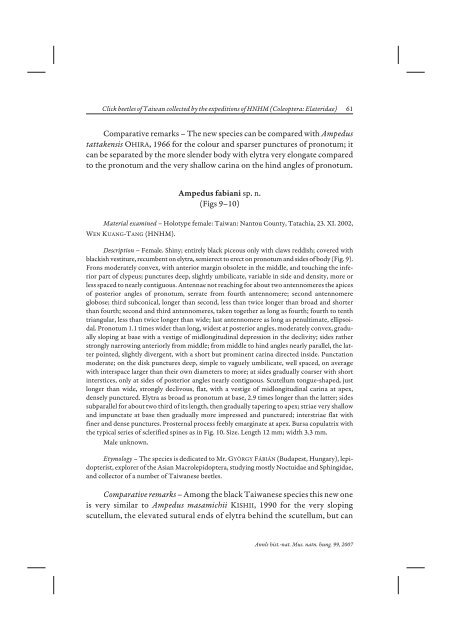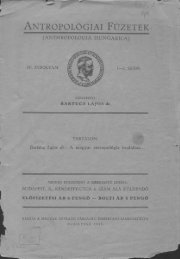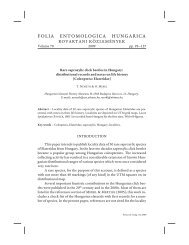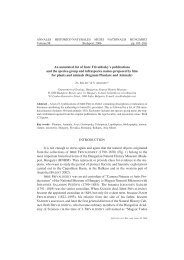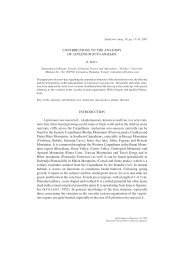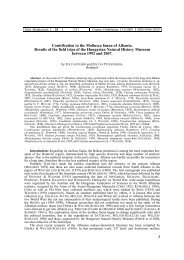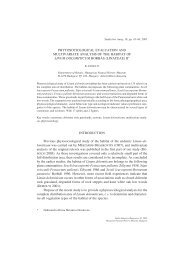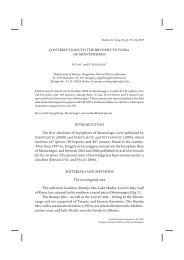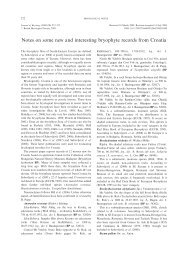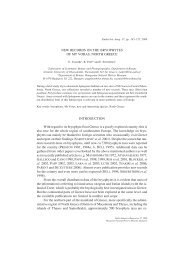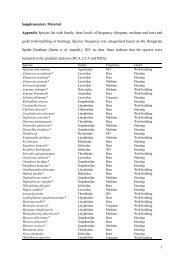You also want an ePaper? Increase the reach of your titles
YUMPU automatically turns print PDFs into web optimized ePapers that Google loves.
Click beetles of Taiwan collected by the expeditions of HNHM (Coleoptera: Elateridae) 61Comparative remarks – The new species can be compared with Ampedustattakensis OHIRA, 1966 for the colour and sparser punctures of pronotum; itcan be separated by the more slender body with elytra very elongate comparedto the pronotum and the very shallow car<strong>in</strong>a on the h<strong>in</strong>d angles of pronotum.Ampedus fabiani sp. n.(Figs 9–10)Material exam<strong>in</strong>ed – Holotype female: Taiwan: Nantou County, Tatachia, 23. XI. 2002,WEN KUANG-TANG (HNHM).Description – Female. Sh<strong>in</strong>y; entirely black piceous only with claws reddish; covered withblackish vestiture, recumbent on elytra, semierect to erect on pronotum and sides of body (Fig. 9).Frons moderately convex, with anterior marg<strong>in</strong> obsolete <strong>in</strong> the middle, and touch<strong>in</strong>g the <strong>in</strong>feriorpart of clypeus; punctures deep, slightly umbilicate, variable <strong>in</strong> side and density, more orless spaced to nearly contiguous. Antennae not reach<strong>in</strong>g for about two antennomeres the apicesof posterior angles of pronotum, serrate from fourth antennomere; second antennomereglobose; third subconical, longer than second, less than twice longer than broad and shorterthan fourth; second and third antennomeres, taken together as long as fourth; fourth to tenthtriangular, less than twice longer than wide; last antennomere as long as penultimate, ellipsoidal.Pronotum 1.1 times wider than long, widest at posterior angles, moderately convex, graduallyslop<strong>in</strong>g at base with a vestige of midlongitud<strong>in</strong>al depression <strong>in</strong> the declivity; sides ratherstrongly narrow<strong>in</strong>g anteriorly from middle; from middle to h<strong>in</strong>d angles nearly parallel, the latterpo<strong>in</strong>ted, slightly divergent, with a short but prom<strong>in</strong>ent car<strong>in</strong>a directed <strong>in</strong>side. Punctationmoderate; on the disk punctures deep, simple to vaguely umbilicate, well spaced, on averagewith <strong>in</strong>terspace larger than their own diameters to more; at sides gradually coarser with short<strong>in</strong>terstices, only at sides of posterior angles nearly contiguous. Scutellum tongue-shaped, justlonger than wide, strongly declivous, flat, with a vestige of midlongitud<strong>in</strong>al car<strong>in</strong>a at apex,densely punctured. Elytra as broad as pronotum at base, 2.9 times longer than the latter; sidessubparallel for about two third of its length, then gradually taper<strong>in</strong>g to apex; striae very shallowand impunctate at base then gradually more impressed and punctured; <strong>in</strong>terstriae flat withf<strong>in</strong>er and dense punctures. Prosternal process feebly emarg<strong>in</strong>ate at apex. Bursa copulatrix withthe typical series of sclerified sp<strong>in</strong>es as <strong>in</strong> Fig. 10. Size. Length 12 mm; width 3.3 mm.Male unknown.Etymology – The species is dedicated to Mr. GYÖRGY FÁBIÁN (Budapest, Hungary), lepidopterist,explorer of the Asian Macrolepidoptera, study<strong>in</strong>g mostly Noctuidae and Sph<strong>in</strong>gidae,and collector of a number of Taiwanese beetles.Comparative remarks – Among the black Taiwanese species this new oneis very similar to Ampedus masamichii KISHII, 1990 for the very slop<strong>in</strong>gscutellum, the elevated sutural ends of elytra beh<strong>in</strong>d the scutellum, but canAnnls hist.-nat. Mus. natn. hung. 99, 2007


